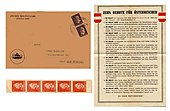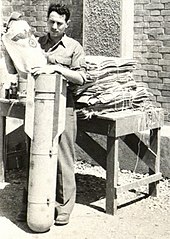Operation Cornflakes
Operation Cornflakes was a measure of operational information planned and executed by the American Office of Strategic Services (OSS) during World War II between 1944 and 1945. The goal was to trick the Reichspost in Nazi Germany into unwittingly delivering anti-Nazi propaganda to German citizens.
To this end, special aircraft were instructed to drop sacks of forged but correctly addressed (with addresses from telephone directories) letters near bombed mail trains. It was hoped that the Reichspost would mistakenly collect the false items during the clean-up work near the impact site and deliver them to the addressees. The mailings thus prepared had been franked with 6 or 12 Pfennig Hitler stamps forged by the OSS and falsely postmarked, so that on superficial examination they should have been regarded as ordinary mailings. All the stamps, as well as the counterfeit mailbags, were produced on an OSS site in Rome.
The corresponding letters often contained issues of the propaganda magazine Das Neue Deutschland, which was published by the Allies in German. In addition, the letters contained counterfeit stamps which, in the style of the standard Reichskanzler Adolf Hitler stamp series, featured the likeness of the "Führer" but which, on closer inspection, showed distortions such as Hitler's face as a skull. The stamp was apparently based on Erwin Blumenfeld's photo collage of Hitler's face from 1933, and the words 'Deutsches Reich' had been replaced by 'Futsches Reich'. Franking the actual letters with these stamps would most probably have led to the discovery of the action.
The first mission of "Operation Cornflakes" took place on February 5, 1945, when a small train on its way to Linz was bombed. Sacks with a total of 3800 propaganda letters were dropped over the destroyed train. These were collected as intended and delivered to the citizens by the Reichspost. Overall, however, it is assumed that only 3% of all letters forged by the OSS were not discovered and destroyed by controls of the German authorities.
The overall effect of Operation Cornflakes is considered to be small. Apart from certain delays in mail delivery caused by the additional censorship measures, there was hardly any discernible "psychological damage". After the end of the operation, an attempt was made to find out, by interviewing prisoners of war, to what extent the psychological measures had had an effect on the behaviour of the soldiers through the forged letters. An estimated number of about 10,000 soldiers was arrived at who had been more or less influenced by the subversive measures. With a production of about 30,000,000 counterfeit letters, stamps, magazines, etc., the total effect may thus be regarded as quite insignificant. In contrast, the effects of the so-called Operation Pig Iron, in which only the propaganda magazine Das Neue Deutschland was distributed, are estimated to be much higher. This was done by dropping miniature editions of the magazine by airplanes.

Fake OSS letter with content

Issue of the propaganda magazine "Das Neue Deutschland", which was often found in forged OSS letters.

Three stamps forged by the OSS for "Operation Cornflakes". The upper two were used for franking, the lower one was enclosed with the letters.

Fake mail bags dropped over mail trains by the OSS.

Loading a "bomb" with fake mailbags as part of Operation Cornflakes. As a rule, however, the mailbags were dropped over the trains without "bomb packaging".
See also
- Operation Sauerkraut
- Stamp counterfeiting
Search within the encyclopedia